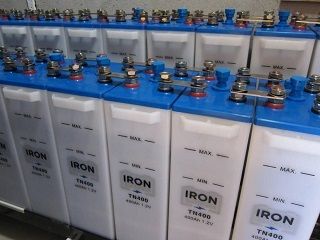From 2GreenEnergy Intern Fabio Porcu: Nickel-Iron Batteries

The electrochemical reactions are as follows:
anode Fe + 2OH– ⇄ Fe(OH)2 + 2e–
catode 2NiO(OH) + 2H2O + 2e− ⇄ 2Ni(OH) + 2OH−
Global reaction is then: Fe + 2NiO(OH) + 2H2O ⇄Fe(OH)2 + 2Ni(OH)2
The more important characteristics of this battery are:
- Specific energy: 19-25 Wh/kg
- Energy density: 30 Wh/l
- Specific power: 100 W/kg
- Time durability: 30 – 50 years
The electrolyte is not consumed during discharge; its sole purpose is to provide the conducting solution. The nominal voltage provided by the cell is about 1.3V and goes down to 1.2V during the discharge phase. Its density does not change with the variation of the amount of charge. The main features of Fe-Ni batteries are their low environmental impact, long service life, low self-discharge rate, and good performance in terms of discharge current.
This type of battery has other good features, such as size and weight. The physical features of the battery are modest, and this results in zero consumption of the electrolyte. However, paradoxically, some of these advantages also cause disadvantages. For example, the slow formation of iron crystals in the electrodes, which guarantees a good service life means that charging is relatively slow.
Another disadvantage of these batteries is the high cost of production which has caused them to slowly replaced by other types of batteries. According to the article from The Iron and Nickel Battery Association, the reason for Fe-Ni battery disappearance from the North American market seems to be caused by Exide Corporation, the second largest manufacturer of lead acid batteries in the world. In 1975 the Exide Corporation had acquired the technology in question from the Edison Storage Battery for several million dollars. The Exide Corporation for unknown reasons has later abandoned this technology.
Nickel–iron batteries have long been used in European mining operations because of their ability to withstand vibration, high temperatures and other physical stress. They are being examined again for use in wind and solar power systems where battery weight is not important.
Many railway vehicles use Ni–Fe batteries; examples include the London underground electric locomotives and New York City Subway car – R62A.
The technology has regained popularity for off-the-grid applications where daily charging makes it an appropriate technology.
Research into Nickel-Iron batteries has not stopped: the University of Victoria is doing research on the use of magneto-hydrodynamic (magnetic agitation) processes to increase the efficiency into the 90% range for NiFe batteries through the work of Dr. Robert O’Brien. The University of Michigan is doing research on the local manufacturing of NiFe batteries in developing countries because of the environmentally friendly chemistry.

Decades ago I worked for a company at which the electric fork lift trucks used nickel-iron batteries. Discharged batteries could quickly and easily be exchanged for freshly charged batteries.
Compared with lead-acid batteries, nickel-iron batteries are more efficient. However, they are (or at least were) somewhat less efficient than lead-acid batteries and their higher internal resistance maked them unsuitable for engine starting or other applications which apply high current surges.
It is unclear why nickel-iron batteries have become less common since in many applications there are a good choice.